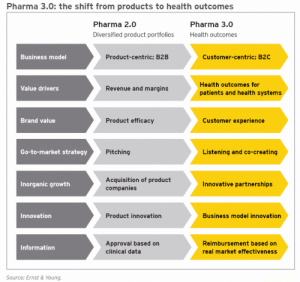 There’s a shift in power in health care moving away from providers and suppliers like pharma and medical device companies, toward patients and payers. This is the new health world according to Ernst & Young‘s latest Progressions report called, The third place: health care everywhere.
There’s a shift in power in health care moving away from providers and suppliers like pharma and medical device companies, toward patients and payers. This is the new health world according to Ernst & Young‘s latest Progressions report called, The third place: health care everywhere.
What’s underneath this tectonic shift is the need to bend that stubborn cost curve and address public health outcomes through behavior change. E&Y says look for new entrants, like retailers, IT companies, and telecomms, to be part of the solution beyond traditional health care stakeholders. These participants will be part of both delivery of care services and play an ever-important and -growing role in “value mining,” which E&Y defines as the use of data mining to determine the value of health interventions. THINK: comparative effectiveness through a lens of value-for-money and you get the picture.
Thus, information is the currency of this health care environment, E&Y say. It’s not only information coming from one direction (providers, pharma, the research community). In the web 2.0 world, there will be co-creation and community engagement where patients, payers, providers and other stakeholders engage together and transparently to co-create content and value.
For industry, this will require a massive commitment to being customer-centric, to focus on that customer’s experience, to listen and co-create, and to be engaged in “radical collaboration” as E&Y puts the case.
The end-game is to co-crate a health system that’s sustainable in terms of cost, quality, and access. At the core of this objective is to motivate and support individual people to engage in healthy behaviors. “Individuals’ actions will be the single largest determinant in the health outcome equation,” Usama Malik of Bridgewater Associates writes in his essay, The next big wave: behavioral change.
Health Populi’s Hot Points: E&Y brings up the concept of the “third place” in that health care will be delivered beyond traditional sites of hospitals and doctors’ offices. The concept comes from Ray Oldenburg, who wrote the book Celebrating the Third Place over 20 years ago. Then, he defined the third place as a public place where people gather to “put aside the concerns of home” (the first place) and work (the second place). In the third place, people connect with others and exchange ideas.
For health care, the third place can be a pharmacy, a school, a church.
In Dr. Regina Benjamin’s parlance, it’s where we “live, work, play and pray.”
I applaud this concept, as I wrote in my report, Primary Care, Everywhere, in November 2011, on behalf of the California HealthCare Foundation. [E&Y, couldn’t you find a different title? It’s very close to the CHCF report’s!]
Notwithstanding my embrace the concept of the third place in health care, I believe it’s the first place — the Home — which is an integral part of the New Medical Home. The bedroom for sleep, the kitchen for healthy eating, the driveway for a pick-up basketball game and skateboarding, our bathroom medicine cabinets for safe and adherent use of prescription drugs, and so on….these are the sites where behavior change happens in our everyday lives. The second place, the workplace, is also key for providing value-based benefits that motivate behavior change through the artful application of carrots and sticks.
So, to paraphrase the Grateful Dead, Health really is Everywhere.




 Interviewed live on BNN Bloomberg (Canada) on the market for GLP-1 drugs for weight loss and their impact on both the health care system and consumer goods and services -- notably, food, nutrition, retail health, gyms, and other sectors.
Interviewed live on BNN Bloomberg (Canada) on the market for GLP-1 drugs for weight loss and their impact on both the health care system and consumer goods and services -- notably, food, nutrition, retail health, gyms, and other sectors. Thank you, Feedspot, for
Thank you, Feedspot, for  As you may know, I have been splitting work- and living-time between the U.S. and the E.U., most recently living in and working from Brussels. In the month of September 2024, I'll be splitting time between London and other parts of the U.K., and Italy where I'll be working with clients on consumer health, self-care and home care focused on food-as-medicine, digital health, business and scenario planning for the future...
As you may know, I have been splitting work- and living-time between the U.S. and the E.U., most recently living in and working from Brussels. In the month of September 2024, I'll be splitting time between London and other parts of the U.K., and Italy where I'll be working with clients on consumer health, self-care and home care focused on food-as-medicine, digital health, business and scenario planning for the future...